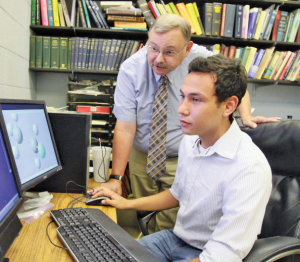By Nadia M. Whitehead
“Some of the problems people are solving these days are so big that they need high computing power,” said Pat Teller, Ph.D., director of research computing at The University of Texas at El Paso. “And if you are using 100 processors rather than just one, you might be able to execute your large problems in 1/100 of the time.”
Teller is responsible for the Research Cloud @UTEP, which is housed in the new Research and Academic Data Center (RADC). The Research Cloud provides users with up to 31 high-performance servers – almost 400 processors – that are connected via a 10-gigabyte network. Even bigger systems are available to UTEP researchers through The University of Texas Research Cyberinfrastructure (UTRC) initiative and Extreme Science and Engineering Discovery Environment (XSEDE), funded by the National Science Foundation.
Users of UTEP’s high-performance computing (HPC) system can be found in nearly every field – from mathematicians and physicists to chemists and mechanical engineers.
“The possibilities are endless with HPC,” Teller said. “You can predict and model the weather, easily sift through the huge digital collections of the Library of Congress to find what you’re looking for, and model and simulate the strength of materials.”

left, and undergraduate researcher Jaime
Valencia are using high-performance
computing to study what happens to
fluorocarbons when they reach the upper
atmosphere. Photo by J.R. Hernandez
For instance, Ricardo Bernal, Ph.D., associate professor of biochemistry, is using UTEP’s HPC system to create three-dimensional reconstructions of a type of protein known as chaperonins.
Using a $2 million cryo-electron microscope (cryo-EM), Bernal and Sudheer Molugu, the cryo-EM facility manager, freeze the proteins and take thousands of photos of them under the microscope.
“The proteins are frozen into the ice in many random orientations – so that’s where high performance computing comes in,” Bernal said. It’s the computer’s job to determine the orientation of every protein relative to every other protein. The computer will then calculate an average of thousands of images to model a chaperonin’s 3-D structure.
By identifying the protein’s structure and how it works, the team can apply the information to better understand chaperonins’ role in certain diseases.
Without HPC, Bernal and Molugu’s research would slow down drastically, or even come to a standstill.
“Having the UTEP high- performance computing resources available to us has been absolutely critical to advance our research,” Bernal said. “We are able to speed up computational analysis of the cryo-EM data by at least tenfold when compared to a powerful lab workstation.”
Carl Dirk, Ph.D., a UTEP professor of chemistry who studies molecular reactions, only recently discovered HPC at UTEP and is excited about its capabilities.
For most of his life, he has used semi-empirical calculations – approximations which are no longer considered “cutting-edge” math.
“In my opinion, it’s a good, predictive method still, but a lot of journals no longer accept semi-empirical results,” he said. Research journals now demand ab initio methods – calculations that are considered highly accurate – which Dirk was unable to perform.
Until now.
In July he started performing ab initio calculations on the high performance computing system. He expected them to take weeks to complete – they were finished in less than 12 hours.
“This new computing system has made me rethink what I can do in terms of computational chemistry. It’s changed my mind about what I thought we could do at UTEP,” he said. “Up until now I thought this would be very difficult to do – that I could never be competitive with other top researchers, but now I can be.”
About 35 researchers use UTEP’s HPC system, but Teller hopes that more University faculty, staff and students will soon hop on the bandwagon to learn what HPC can do for them.
“If people engage themselves and adopt this computing, it can certainly accelerate their research, results and even grant funding,” she said.
For those interested in using the system, the RADC offers three-to-five-day training courses throughout the year. Learn more at researchcomputing.utep.edu.